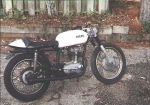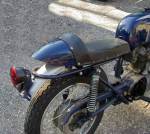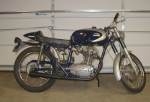Ducks in a Row Part II
 After almost a year we
have finally finished Jim's scrambler. The delay was more due to
procrastination on our part than from any particular difficulty
with the restoration job. After getting the white beast to Jim's
house we first tried to start it up. We could see right a way
that the stator wire coming out of the crankcase had rotted to
the point where bare wires were showing through the remnants of
the insulation. We simply arranged them so they did not touch
anything for the start up. We put the tank on the frame with a
couple of bolts and connected the fuel lines. After putting some
gas in the tank we were pleasantly surprised to see that there
were no leaks. Next we located the points wire and connected that
to a hot battery. Bingo! It started on the second or third kick
and sounded really great. After cruising the neighborhood for 15
minutes or so we were convinced that the engine and transmission
were sound. There was another problem, however. The kick-starter
would only engage if the bike were leaned way to the right.
Obviously a spring in the starter mechanism was not functioning.
It was time for the clean up to begin.
After almost a year we
have finally finished Jim's scrambler. The delay was more due to
procrastination on our part than from any particular difficulty
with the restoration job. After getting the white beast to Jim's
house we first tried to start it up. We could see right a way
that the stator wire coming out of the crankcase had rotted to
the point where bare wires were showing through the remnants of
the insulation. We simply arranged them so they did not touch
anything for the start up. We put the tank on the frame with a
couple of bolts and connected the fuel lines. After putting some
gas in the tank we were pleasantly surprised to see that there
were no leaks. Next we located the points wire and connected that
to a hot battery. Bingo! It started on the second or third kick
and sounded really great. After cruising the neighborhood for 15
minutes or so we were convinced that the engine and transmission
were sound. There was another problem, however. The kick-starter
would only engage if the bike were leaned way to the right.
Obviously a spring in the starter mechanism was not functioning.
It was time for the clean up to begin.
The first step was to replace the stator wires as I had done
on my Sebring. This time, however, we were in for a pleasant
surprise. When we took the primary cover off we found that
someone had drilled and tapped two holes in the flywheel which
allowed us to remove it with a steering wheel puller. Boy did
this help! Once the flywheel was removed we could see the stator
clearly and were able to solder the new leads directly on to the
coils.
We next turned our attention to the kick-starter. The starter
gear is pushed into the transmission shaft by a small leaf
spring. The spring was not broken but rather had been bent back
so it no longer engaged the starter pawl. Finding a replacement
was not easy so in the end we simply bent it back into place. We
buttoned up the primary side and the kick-starter seemed to work
fine. With the engine work complete we decided that it was time
for a paint job.
 Now Jim's bike was not
nearly as complete as my Sebring was. There were no fenders or
head light. It had a tank but the tank was actually from a
Benelli 125 (sold in America by Wards under the Riverside name)
but it looked pretty good on the Duck. It touched the cylinder
head though and made a rattle. A ball-peen hammer quickly fixed
the clearance problem and was done in a reasonably unnoticeable
way. I had a round front Ducati fender that was originally on my
Sebring when I bought it. I replaced the round fender with the
correct square fender making the round fender available for
Jim's. The round fender would have been the correct one on Jim's
bike anyway. Jim also had a Ducati 250 scrambler hulk in the junk
pile behind the Honda shop where he works. The hulk donated a
rear fender. The best thing about Jim's bike was the funky café
racer seat that some one had installed. We rigged up the rear
fender and made proper mounting hardware for the seat.
Now Jim's bike was not
nearly as complete as my Sebring was. There were no fenders or
head light. It had a tank but the tank was actually from a
Benelli 125 (sold in America by Wards under the Riverside name)
but it looked pretty good on the Duck. It touched the cylinder
head though and made a rattle. A ball-peen hammer quickly fixed
the clearance problem and was done in a reasonably unnoticeable
way. I had a round front Ducati fender that was originally on my
Sebring when I bought it. I replaced the round fender with the
correct square fender making the round fender available for
Jim's. The round fender would have been the correct one on Jim's
bike anyway. Jim also had a Ducati 250 scrambler hulk in the junk
pile behind the Honda shop where he works. The hulk donated a
rear fender. The best thing about Jim's bike was the funky café
racer seat that some one had installed. We rigged up the rear
fender and made proper mounting hardware for the seat.
The headlight was a problem. We also had the remains of a
Sears 124 in the junk pile. The head light shell was still good
and fit nicely in the Ducati forks. The switch was history,
however. Jim located an Italian switch unit at Domi Racer
complete with key for a good price. We studied the switch pattern
and soon figured a way to make it work in the Duck. It was easily
mounted in the Sears headlight shell and we were in business. Now
that all the sheet metal seemed complete and it was ready for
paint.
I took the bike over to my shop where I completely dismantled
it. The frame, seat, and tank were painted with royal blue
synthetic enamel. The fenders headlight shell and tank panel were
painted silver. Domi Racer had the tank decals and a funky decal
for the top of the tank touting all of the racing victories
claimed by Ducati in the 60's. This was factory installed on all
Ducatis in those days and looked great. After placing the decals
and some gold pin stripe tape Carlos Forte and I clear-coated the
tank using a clear enamel top coat with a polyurethane hardener.
It looked pretty good.
The next chore was the rusty rims. Jim located some 18"
36-hole rims and we laced them up with Buchanen stainless steel
spoke sets. Jim bought some 3.50 x18 in tires to finish the job.
We found out latter, however, that 3.50 tire would not clear the
front fender and we had to drop down to a 2.75 x 18 skin for the
front.
 We
had to wire the thing from scratch. The wiring
diagram in the service manual has wires running every where
but if you unravel them it's actually pretty simple. Click here
to see a simplified Ducati wiring
diagram. The Ducati came with a big ugly voltage regulator
under the seat. I had decided to take mine apart to see what was
inside. There are no relays or anything exotic. It works on a
saturating inductor principle similar to a constant voltage
transformer. The inductors (coils) are what make the regulator so
big and heavy. It also contains several diodes to rectify the AC
current from the alternator. Click here to see a schematic of the regulator. Although I took
the regulator apart, you can completely test one with an Ohmmeter
without actually opening it. Also, note that there is a fuse
hidden under the top cover on the regulator. A blown fuse is a
common cause of a dead system in a Ducati. Click here for step-by-step instructions on
how to test a Ducati charging system. The Domi Racer switch
seemed to have all of the functions needed and soon all of the
electricals were working.
We
had to wire the thing from scratch. The wiring
diagram in the service manual has wires running every where
but if you unravel them it's actually pretty simple. Click here
to see a simplified Ducati wiring
diagram. The Ducati came with a big ugly voltage regulator
under the seat. I had decided to take mine apart to see what was
inside. There are no relays or anything exotic. It works on a
saturating inductor principle similar to a constant voltage
transformer. The inductors (coils) are what make the regulator so
big and heavy. It also contains several diodes to rectify the AC
current from the alternator. Click here to see a schematic of the regulator. Although I took
the regulator apart, you can completely test one with an Ohmmeter
without actually opening it. Also, note that there is a fuse
hidden under the top cover on the regulator. A blown fuse is a
common cause of a dead system in a Ducati. Click here for step-by-step instructions on
how to test a Ducati charging system. The Domi Racer switch
seemed to have all of the functions needed and soon all of the
electricals were working.
When the time came to start it up and take a test ride the
kick starter failed again. In the intervening time Garry Owen in
Atlanta had sent Jim a replacement spring. So Jim opened the
primary case and installed the new spring.
While the Ducati was taking shape on the work stand it caught
the eye of Nigel Smith. Nigel coveted the Ducati and soon struck
a deal trading several basket-case Triumphs and a basket case
Cushman Eagle for the Duck. Nigel no sooner got the Ducati home
than the kick start spring let go again. Nigel soon learned the
art of leaning the Duck to the right before kicking it. It turns
out that gravity is actually enough to engage the pawl. Nigel is
working the Kinks out of the Ducati and Jim is now struggling
with the ultra high-tech Eagle. The end of the story is that
Nigel won 2nd place at the Dauphin Island Spring
Festival Mororcycle show with the good looking duck.
Return to Home
 After almost a year we
have finally finished Jim's scrambler. The delay was more due to
procrastination on our part than from any particular difficulty
with the restoration job. After getting the white beast to Jim's
house we first tried to start it up. We could see right a way
that the stator wire coming out of the crankcase had rotted to
the point where bare wires were showing through the remnants of
the insulation. We simply arranged them so they did not touch
anything for the start up. We put the tank on the frame with a
couple of bolts and connected the fuel lines. After putting some
gas in the tank we were pleasantly surprised to see that there
were no leaks. Next we located the points wire and connected that
to a hot battery. Bingo! It started on the second or third kick
and sounded really great. After cruising the neighborhood for 15
minutes or so we were convinced that the engine and transmission
were sound. There was another problem, however. The kick-starter
would only engage if the bike were leaned way to the right.
Obviously a spring in the starter mechanism was not functioning.
It was time for the clean up to begin.
After almost a year we
have finally finished Jim's scrambler. The delay was more due to
procrastination on our part than from any particular difficulty
with the restoration job. After getting the white beast to Jim's
house we first tried to start it up. We could see right a way
that the stator wire coming out of the crankcase had rotted to
the point where bare wires were showing through the remnants of
the insulation. We simply arranged them so they did not touch
anything for the start up. We put the tank on the frame with a
couple of bolts and connected the fuel lines. After putting some
gas in the tank we were pleasantly surprised to see that there
were no leaks. Next we located the points wire and connected that
to a hot battery. Bingo! It started on the second or third kick
and sounded really great. After cruising the neighborhood for 15
minutes or so we were convinced that the engine and transmission
were sound. There was another problem, however. The kick-starter
would only engage if the bike were leaned way to the right.
Obviously a spring in the starter mechanism was not functioning.
It was time for the clean up to begin. 